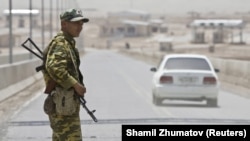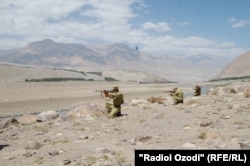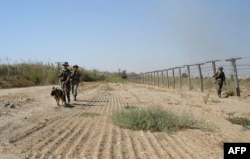SHURO-OBOD, Tajikistan -- Villagers in southern Tajikistan along the border with war-torn Afghanistan have been told they should be prepared "to take up arms" if militants try to enter the region.
Local authorities in the Tajik district of Shamsiddin Shohin have held meetings with residents -- including army reservists and hunters -- to discuss the situation, Governor Pochokhon Zarifzoda says.
"In coordination with the police and intelligence departments, we've registered all hunters who live in the border areas. They will have to take up arms to defend our country. In fact, all of us will have to take up weapons if the situation dictates," Zarifzoda said in an official meeting on March 6.
Similar warnings are being issued in other Tajik districts near the mountainous border, which is marked by the Panj River.
Authorities, however, have not provided any details about their plans to train the men who they say could be given weapons to help defend the border.
It comes as fighting between the Afghan National Army and the Taliban and other insurgent groups has intensified in areas close to Tajikistan in recent months. Adding to concerns in Dushanbe, Afghan officials have warned that there are many Tajik nationals fighting with the militants.
In very rocky, mountainous terrain of brush and cliffs, much of the 112-kilometer border between Shamsiddin Shohin and northeastern Afghanistan is considered one of the most difficult parts of the frontier for Tajik border troops to control.
As in many Tajik border villages, people in Shamsiddin Shohin are used to hearing the sound of gunfire coming from Afghanistan and even fear being struck by a stray bullet or artillery shell.
Two weeks ago, several bullets and shells fired from Afghanistan landed in the backyards of two residential houses and a school in the nearby village of Ruzvai in the Darvoz district.
Tajik villagers narrowly missed being hit by gunfire from an exchange between Afghan government forces and the Taliban during a night of fighting on February 24 in Afghanistan's Nusai (Darwaz) district.
The following day, Nusai Governor Zainalabedin told RFE/RL there had been at least two Tajik citizens among the militants killed in the clashes. He identified them as Muhammad Yunus and Huzaifa.
It's unlikely the names will provide any clues for Tajik authorities as many Central Asian militants who fight abroad usually get new nicknames, which are often Arabic-style.
Zainalabedin called on Dushanbe to cooperate in the fight against the militants and Tajik nationals who the governor described as affiliates of the Taliban and the Islamic State group.
Afghan officials put the number of Tajik militants fighting in Afghanistan at around 200, but it's not possible to verify that number.
Border Reinforcement
Dushanbe has long been concerned about the concentration of militants -- including insurgents from Central Asia -- in Afghanistan near the 1,360-kilometer border the countries share.
In December, Tajikistan deployed additional troops along the border after reports emerged that a group of Tajik militants had helped the Taliban overrun an Afghan district several days before.
Some 10 minutes of footage on social media purportedly showed Tajik insurgents fighting against Afghan forces in Maymay, which borders Tajikistan.
The video showed several fighters killing men in Afghan National Army uniforms and civilian clothes while setting a building on fire. Some of the insurgents can be heard speaking a distinct Persian dialect that is spoken in Tajikistan.
RFE/RL cannot verify the authenticity of the video, which Afghan politician Latif Pedram said depicted a militant attack on Maymay in November 2020.
Pedram, a native of the area, also published a list of names he described as insurgents from Tajikistan who took part in the Maymay raid.
Within days, security services in Tajikistan identified at least 15 Tajik citizens who appeared on the video or had their names included in the lists and statements shared by Afghan officials in connection with the Maymay fighting.
Afghan officials say the Tajik insurgents who took part in that raid belong to Jamaat Ansarullah, a militant group founded in Afghanistan by Tajik national Amriddin Tabarov in 2010. Tabarov was killed by Afghan forces in July 2015.













